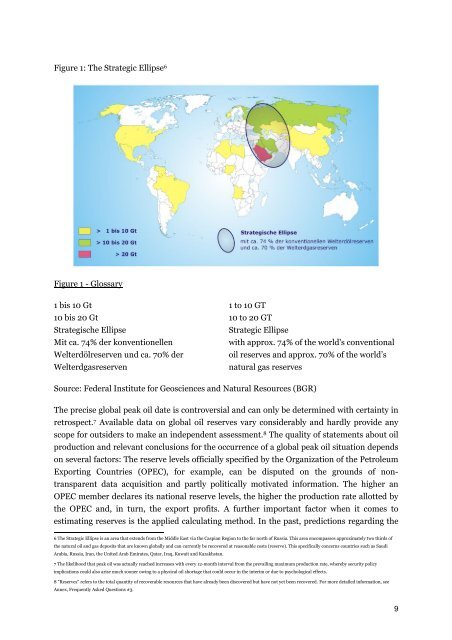PEAK OIL
PEAK OIL
PEAK OIL
Create successful ePaper yourself
Turn your PDF publications into a flip-book with our unique Google optimized e-Paper software.
Figure 1: The Strategic Ellipse 6<br />
Figure 1 - Glossary<br />
1 bis 10 Gt 1 to 10 GT<br />
10 bis 20 Gt 10 to 20 GT<br />
Strategische Ellipse Strategic Ellipse<br />
Mit ca. 74% der konventionellen<br />
with approx. 74% of the world's conventional<br />
Welterdölreserven und ca. 70% der<br />
oil reserves and approx. 70% of the world’s<br />
Welterdgasreserven<br />
natural gas reserves<br />
Source: Federal Institute for Geosciences and Natural Resources (BGR)<br />
The precise global peak oil date is controversial and can only be determined with certainty in<br />
retrospect. 7 Available data on global oil reserves vary considerably and hardly provide any<br />
scope for outsiders to make an independent assessment. 8 The quality of statements about oil<br />
production and relevant conclusions for the occurrence of a global peak oil situation depends<br />
on several factors: The reserve levels officially specified by the Organization of the Petroleum<br />
Exporting Countries (OPEC), for example, can be disputed on the grounds of nontransparent<br />
data acquisition and partly politically motivated information. The higher an<br />
OPEC member declares its national reserve levels, the higher the production rate allotted by<br />
the OPEC and, in turn, the export profits. A further important factor when it comes to<br />
estimating reserves is the applied calculating method. In the past, predictions regarding the<br />
6 The Strategic Ellipse is an area that extends from the Middle East via the Caspian Region to the far north of Russia. This area encompasses approximately two thirds of<br />
the natural oil and gas deposits that are known globally and can currently be recovered at reasonable costs (reserve). This specifically concerns countries such as Saudi<br />
Arabia, Russia, Iran, the United Arab Emirates, Qatar, Iraq, Kuwait and Kazakhstan.<br />
7 The likelihood that peak oil was actually reached increases with every 12-month interval from the prevailing maximum production rate, whereby security policy<br />
implications could also arise much sooner owing to a physical oil shortage that could occur in the interim or due to psychological effects.<br />
8 "Reserves" refers to the total quantity of recoverable resources that have already been discovered but have not yet been recovered. For more detailed information, see<br />
Annex, Frequently Asked Questions #3.<br />
9


